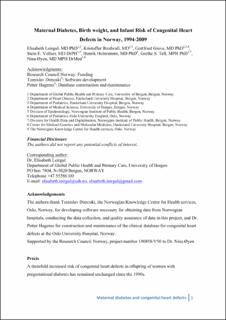| dc.description.abstract | Objective: To investigate the association between pregestational or gestational diabetes and offspring risk of congenital heart defects and the association between large-for-gestational-age birth weight and risk of cardiac defects in offspring of diabetic women.
Methods: Information on pregestational and gestational diabetes, cardiac defects, and birth weight among all births in Norway in 1994–2009 was ascertained from the Medical Birth Registry of Norway, national health registries, and the Cardiovascular Disease in Norway project. The relative risk (RR) compared offspring risk of cardiac defects for maternal diabetes with offspring risk in nondiabetic mothers adjusted for year of birth, maternal age, and parity.
Results: Among 914,427 births (live births, stillbirths, terminated pregnancies), 5,618 (0.61%) were complicated by maternal pregestational diabetes and 9,726 (1.06%) by gestational diabetes. Congenital heart defects were identified in 10,575 offspring. The prevalence of cardiac defects differed between groups: 344 of 10,000 births to women with pregestational diabetes, 172 of 10,000 to women with gestational diabetes, and 114 of 10,000 in women without diabetes (adjusted RRs 2.92, 95% confidence interval [CI] 2.54–3.36 and 1.47, 95% CI 1.26–1.71). During the study period, the adjusted RRs for congenital heart defects did not change. The risk of cardiac defects in neonates very large for gestational age (birth weight greater than 3 standard deviations above the mean) was compared with neonates with birth weight appropriate for gestational age. For pregestational diabetes, the prevalences of offspring cardiac defects were 561 compared with 248 per 10,000 births (adjusted RR 2.23, 95% CI 1.39–3.59) and for gestational diabetes 388 compared with 132 per 10,000 (adjusted RR 2.73, 95% CI 1.53–4.85).
Conclusion: The increased risk of having a child with a congenital heart defect has not changed for diabetic women in Norway since 1994. Among women with pregestational or gestational diabetes, having a large-for-gestational-age neonate was associated with a two- to threefold increased risk of cardiac defects compared with neonates with normal birth weight. | en_US |
